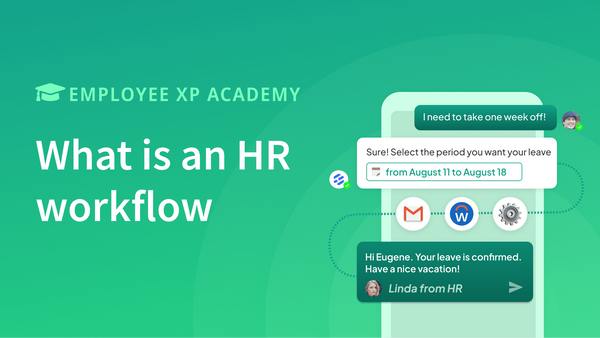HR SLA, why should you be open about it in your company?
The SLA (Service Level Agreement) is a key component of enhancing HR Support quality and making sure employees get the best possible service, hence improving Employee Experience and engagement at work greatly.
But what exactly is an SLA? And why should you care about it if you're an HR professional? In this post, I'll try to explain why an HR SLA is important, how to set one up, and how to monitor performance against it.
What is an HR SLA?
Historically, the notion of SLA has been created to make sure IT contractors were contractually bonded to respect a certain level of quality, security, reactivity, and availability of the software they provide to their customers.
They would define in the contract different notions of service quality (time to answer a ticket, time to solve an issue) based on the gravity of the issue and would track that time during the whole length of the contract. A penalty would be defined in advance in case of an SLA breach, all that to protect the customers in case of an issue with the software they paid for.

Applied to HR, an HR SLA is the Service Level Agreement between the HR support team and the employee. It’s a promise to an employee about how long it will take to answer their question, and it’s also a commitment and contract between the employee and the HR team not to expect more than the defined SLA. Your SLA is composed of different metrics, hereafter is a few examples.
- Time to first reply - which is when the problem is handled
- Time to last reply - when the issue is resolved
- And most important, the RTO (Response Time Objective) - The maximum time your employees should expect a response from the HR Support Service.
Why is it important to be transparent about your RTO with employees?
Transparency and open communication about your RTO is of paramount importance. It's not really about having the shortest RTO; it's about communicating on it and respecting it. Better have a 5-day RTO that is always respected than a pressuring 24h that is respected only half of the time!
By being transparent, you also help ensure your employees are satisfied with your services—which will, in turn, lead back to improved employee retention rates over time!

Communicating your RTO also leads to better time management and planning: it allows your employees to make decisions based on what they know about your RTO instead of being left guessing or wondering whether their requests will be fulfilled.
When you communicate your HR RTO, you are building a culture of quality and trust. You let your employees know what to expect from the services that they receive from your HR team. You can also use this opportunity to let them know how they can get in touch with someone if they have a concern or complaint about the service that was provided.
How should I set my HR SLA?
The first step in setting your HR SLA is to look at what you expect from your team and how many people are on it. For example, if you have a small HR team of 2 persons and receive 100 requests a week, that means that each person has to answer 50 requests per week (10 requests per day). A normal request takes around 12 minutes to process; they will thus have to dedicate around 2 hours a day each to answer those requests.
Depending on their HR portfolio (what other running activities they have and how much time a day they spend on them), 24h to 48h SLA seems reachable. If the number of questions increases, though, they might need more time to spend answering them and dedicating a whole day or two to doing so. Your SLA will, of course, extend as the support organization changes.

Another factor is the complexity of your requests: if you receive only simple questions like "How do I apply for vacation?" (Tier 1), then this will take less time than something more complicated like "Do I qualify for an increased pay grade?" (Tier 2 or Tier 3). It is a good practice to split your SLA by complexity, having, for instance, 24h for Tier 1 issues, 2 days for Tier 2, and 5 days for Tier 3.
How to monitor HR SLA performance?
To monitor the performance of HR SLA, you should be keeping track of:
- The number of questions asked.
- The number of tickets created.
- The average time to answer questions (ATAQ) and tickets (ATT) by category
- ATAQ and ATT for each employee
Those KPIs are the main ones that you should focus on while starting to implement an SLA Strategy, but by becoming more and more expert in it, you will soon discover that you can find hundreds of data points to be tracked to monitor your SLA. (ticket processed per agent, per team, per category, per level of complexity, time a ticket stays in a specific status, first-time resolution ratio, SLA per channel…).
Most of today’s HR Ticketing systems, such as our platform Clevy OnDemand, or even Service Now for HR, or Salesforce at Work, will let you track all those data in an aggregated way to help you monitor and improve your SLA processes over time.
But remember to start simply. SLA is a mindset and has operational impacts. It is not about having everything right the first time, it is about starting somewhere and continuously improving the process.
How to set expectations for your HR Support teams?
It’s also important that you set clear expectations for your HR support teams, so they know what’s expected of them and how they should be performing. To do this, you need to communicate the SLA to employees. As you monitor the performance of your teams, provide feedback on how well they are meeting their goals.
Also, make sure that if there are any issues with the service level agreement or if there is room for improvement, you can work together with the team members to improve it.
HR teams are not IT, and they are definitely not customer service. Answering employee questions is only part of the myriad things they have to do every day to make sure the company runs smoothly. So it is of paramount importance to not impose SLA on them but rather define SLA with them and improve them over time. You want your HR happy and engaged, or the whole machine will definitely break.
Conclusion
Ultimately, HR SLAs are becoming more and more important as they provide a way to set expectations and communicate them clearly with employees. The value of communication and transparency cannot be overstated.
In fact, the more you communicate with your employees about what to expect from the HR team and how they can help them achieve their goals, the better it will be for everyone involved, leading to less frustration and better engagement for HR teams and employees alike.




